Two in one: Intel Optane Memory H10 (Part 1)
- Transfer
Part 1 >> Part 2
SSD caching has been around for a long time, and allows you to squeeze maximum performance out of fast storage devices. In recent years, Intel Optane products using non-volatile 3D XPoint memory have ruled in the realm of small, expensive, and very fast drives. With Intel's third-generation Optane Memory caching memory, Optane's performance will qualify for a new product segment.
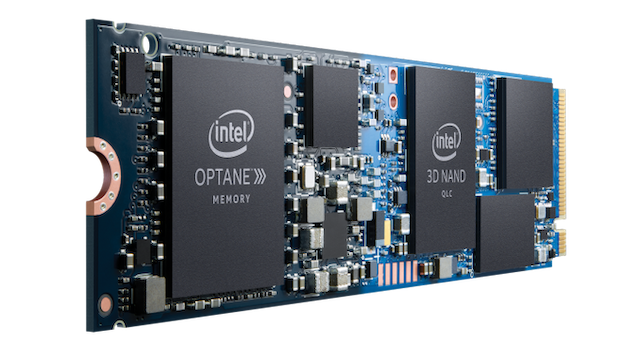
The first Optane Memory drives were tiny NVMe SSDs designed to speed up access to slower SATA drives, especially mechanical hard drives. Intel is currently continuing to use Optane memory SSDs to cache other NVMe SSMs, focusing on a combination of Optane flash memory and QLC NAND. Now they have put both types of SSDs on the same M.2 module to create the new Optane Memory H10.
For the first time, Intel Optane Memory H10 allows Intel to implement its Optane Memory caching technology in ultrabooks, where there is room for only one SSD, there is nothing to talk about SATA. The squeezing of two disks into a single-sided 80 mm M.2 module was made possible, in particular, due to the high density of Intel's four-bit flash memory QLC NAND. The Intel 660p QLC SSD has a lot of free space on the board in versions 1 TB and 512 GB, the Optane cache can potentially compensate for the shortcomings of the QLC NAND in performance and durability. Even with the placement of two types of memory on one module, the design of the H10 is very simple.

The Optane Memory H10 does not use any new ASIC or other hardware to make the Optane and QLC drive modules look like a single device. Caching is fully software-controlled, and the host system independently accesses Optane and the QLC H10. Each half of the drive has two dedicated PCIe lanes. Previously, all Optane Memory SSDs were PCIe x2 devices, so they don’t lose anything in the new device. But Intel 660p uses a 4x controller Silicon Motion NVMe, which is now limited to two lines of PCIe. Although, frankly, the 660p almost never required more bandwidth than the x2 channel can provide, so this is not really a bottleneck.

With slow QLC SSDs and Optane fast SSDs on the same Intel device, it was difficult to make difficult decisions about drive performance. For two large H10 capacities (512 GB and 1 TB), sequential read speeds of more than 2 GB / s are declared. This reflects the ability of Intel Optane Memory software to extract data from both QLC and Optane H10 at the same time. Recording can also alternate between different types of memory, but the maximum rating does not exceed any obvious limit for the performance of any of the devices. The specifications for random I / O for the H10 are between the performance of Optane Memory and 660p SSD devices, but much closer to Optane's performance. Intel is not trying to advertise the ideal cache hit rate, but they expect
The Optane cache should reduce the load that the QLC H10 writes, but Intel still estimates the endurance of the entire device as the same 0.16 disk rewrites per day. This is the same endurance as 660p QLC SSDs.

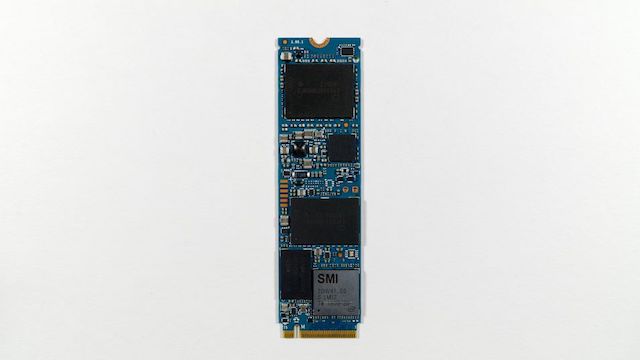

Marketing photographs of the Intel Optane Memory H10 feature an SSD with a two-color PCB to emphasize the dual nature of the drive, but in fact the drive board is monochrome. The layout of the board is unique thanks to two controllers and three types of memory, but it also clearly shows the two discrete products on which it is based. Half of the drive with QLC NAND is closer to the M.2 connector and is equipped with an SM2263 controller, plus one DRAM and NAND package. The familiar Silicon Motion test / debug connections are located on the border between NAND and Optane. The Optane side contains a small Intel Optane controller, a single 3D XPoint memory package, and most power management components. Intel SSD 660p and earlier solid-state drives with Optane Memory had a lot of free space on printed circuit boards;

At first glance, the Optane Memory software has barely changed; unless there’s now more flexibility in choosing caching devices. (Intel announced enhanced Optane Memory support for Pentium and Celeron processors on platforms that were already supported by Core processors.) If the boot volume is cached, Intel software allows the user to cache the selected files and applications to prevent them from being removed from the cache. Other than this option, there are no cache behavior settings.
Some OEM selling systems equipped with Optane Memory reported memory sizes as the sum of DRAM and Optane. That would make sense when we talk about Optane DC read-only memory modules connected to the processor's memory controller; what is misleading is the fact that the Optane product in question is an SSD.
Initially, the Optane Memory H10 will be an OEM-only part. The new SSD will be available to consumers only as a component of new systems, primarily laptops. Intel is currently considering the possibility of releasing the H10 in retail - both as a standalone product and as part of the NUC kit, no timing has been announced. Their motherboard partners have been setting the stage for H10 support for almost a year, and many desktop 300 series motherboards already support H10 with the latest publicly available firmware.
Placing two PCIe devices on the same M.2 card is new, to say the least. Intel has already installed two SSD controllers on one circuit board - in corporate high-end SSDs, for example, P3608 and P4608, but these drives use PCIe switch chips to split the x8 host connection into two x4 hosts for each of the two NVMe controllers on the board . This approach inflates the TDP of the device to 40 watts, which is not at all useful under the limitations of M.2.
There are several PCIe expansion cards that allow you to connect four M.2 PCIe SSDs through one PCIe x16 slot. Some of these cards include PCIe switches, but most use a host system that supports dual PCIe ports to split one x16 port into four independent x4 ports. Conventional consumer CPUs usually do not support this, and are limited to splitting x8 + x4 + x4 or just x8 + x8, and only when the lines are redirected to different slots to support the use of multiple GPUs. The latest processors for servers and workstations are more likely to support port separation up to x4, but motherboard support to enable this feature is not everywhere.
Even on processors where the x16 slot can be divided into four x4 ports, further separation up to x2 ports is rare or not possible at all. Chips that support many PCIe lanes, such as narrow x2 or x1 ports, are southbridge / PCH chips on most motherboards. As a rule, they do not support ports wider than x4, because this is the normal width of the connection to the processor.
Based on the foregoing, we tried Optane Memory H10 with almost all of the available PCIe 3.0 ports, using all the necessary adapters. Our results are shown below:

The Whiskey Lake notebook provided by Intel for this review is, of course, fully compatible with the Optane Memory H10 and will soon be available for purchase with the new drive. Compatibility with older and non-Intel platforms is basically what was expected: only the NAND H10 side is available. On these motherboards it will not be possible to use two PCIe devices that have a common M.2 x4 slot - they are not able to detect and initialize both devices. There are a few exceptions to note:
Firstly, the H370 motherboard in our Coffee Lake system was supposed to fully support H10, but GIGABYTE released a spoiled firmware update that supposedly added support for H10: both parts of NAND and Optane H10 became available when using the M.2 slot that connects to PCH , but caching cannot be enabled. There are many 300 series motherboards that have successfully added support for H10, and I am sure that GIGABYTE will soon release a patched firmware update for this specific board. Connecting the H10 to the PCIe x16 slot, which is connected directly to the CPU, does not provide access to the Optane side, reflecting the CPU's lack of support for PCIe port separation up to x2 + x2.
The only modern AMD system we had on hand was the Threadripper / X399 motherboard. All the PCIe and M.2 slots that we tried made the Optane H10 side visible, but could not detect the NAND.
We connected the H10 through two different brands of PCIe 3.0 switch. Avago PLX PEX8747 provided access only to the NAND side, which is to be expected, since it only supports dual PCIe ports up to x4 ports. The Microsemi PFX PM8533 switch supports split up to x2, and we hoped it would give access to both sides of the H10, but instead only got access to half of the Optane. The Microsemi switch and Threadripper motherboard may only need a firmware update to work with both halves of the H10; earlier generations of Intel PCH may have this potential, but Intel will not provide such updates. Even if these platforms could access both halves of the H10, they would not be supported by Intel's Optane Memory caching drivers. True,
Our main system for testing consumer SSDs is the Skylake desktop computer. It features a Quarch XLC programmable power module for detailed power measurements, and is used for IO ATSB trace tests and synthetic tests using FIO. But our system is older than Optane Memory, and Intel and their motherboard partners did not want to release firmware updates to support Optane Memory caching in Skylake generation systems. As a result, with the help of our test bench we can access only half of the disk - QLC NAND.

As happens with the release of the new Optane Memory, Intel sent us an entire system with the new Optane Memory H10 already installed and configured. So now the system for testing is an HP Specter x360 13t laptop with an Intel Core i7-8565U Whiskey Lake processor and 16 GB of DDR4 memory. In previous years, Intel provided desktop systems for testing Optane Memory products, but the main advantage of the H10 is that it is one M.2 module that is suitable for small systems, and therefore a 13-inch laptop was chosen. Intel has confirmed that the Specter x360 will soon be available for sale with the Optane Memory H10 as one of its storage options.
The HP Specter x360 13t has only one M.2 type-M slot, therefore, to test the caching configurations on multiple disks or options using SATA, we used the Coffee Lake and Kaby Lake systems that Intel provided for previous releases of Optane Memory. Application test results, such as SYSmark and PCMark, are greatly affected by differences in processor power and RAM between these machines, so we must list three sets of ratings for each tested disk configuration. However, our AnandTech Storage Bench I / O tests and our synthetic tests using FIO give almost identical results for these three systems, so we can make direct comparisons, and for each such test we list one set of points for each storage configuration.
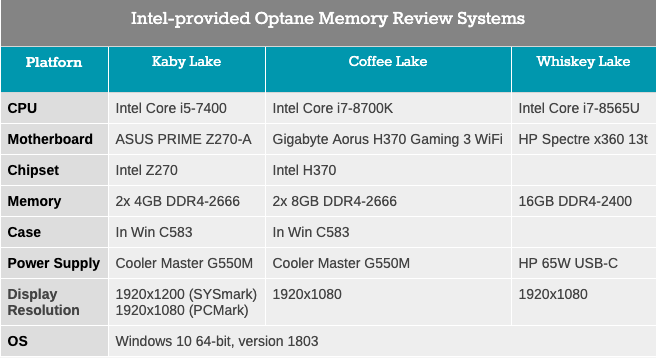
The Intel Optane Memory caching software is for Windows only, so our Linux-based synthetic FIO testing had to be adapted to run on Windows. The configuration and testing procedure is as close as possible to our usual methodology, but some important differences mean that the results of this review cannot be directly compared with the results of our usual SSD reviews and the results published in Bench. In particular, in some cases, it was not possible to safely erase or format NVMe from Windows. Our testing typically involves erasing the disk between the main phases to restore performance, without waiting for the background SSD garbage collection to complete the flushing and clearing of the SLC cache. In a review of synthetic tests based on Windows tests,
Optane memory caching requires the use of Intel drivers. Our usual procedure for Windows-based tests is to use Microsoft's own NVMe driver, but not to use vendor-specific drivers. The Optane caching configuration tests in this review were conducted with Intel drivers, but the Windows driver is used by default in all tests with one drive (including tests on only one side of the Optane Memory H10).
Our standard Skylake test bench is designed to test NVMe SSDs in the main PCIe x16 slot connected to the processor. Optane memory caching requires the drives to be connected via the chipset, so there is little chance that overload on the x4 DMI channel may affect the fastest drives, but the H10 is unlikely to saturate this connection.
We try to include detailed power measurements in almost all of our performance tests, but in this review we are forced to skip many of them. Our state-of-the-art power measuring equipment cannot supply power to the M.2 slot in a laptop; it requires a regular PCIe x4 slot.
With a sophisticated tiered storage system like the Intel Optane Memory H10, the most accurate benchmarks will be tests that use real-world applications. BAPCo's SYSmark 2018 and UL's PCMark 10 are two competing sets of automated application tests. Both have a common goal - to provide an assessment of the overall performance of the system, as well as several additional assessments covering various common use cases. PCMark 10 is a shorter test, and it provides a more detailed breakdown of various parameters. It also loads the GPU much more heavily, since 3D rendering is included in the standard test suite, and some 3DMark tests are included in the advanced test. The advantage of SYSmark 2018 is the use of full commercial versions of popular applications, including Microsoft Office and Adobe Creative Suite, and it includes the ability to measure the overall power consumption of the system during the test. The disadvantage of these tests is that they cover only the most common cases of everyday use, and do not simulate a heavy multitask load. None of their subtests uses the storage intensively, so often scores vary slightly when comparing fast and slow SSDs.
BAPCo SYSmark 2018 is an application-based benchmark that uses real-world applications to simulate the behavior of business users, with additional indicators of productivity, creativity and responsiveness. The results reflect the overall system performance and are calibrated against a reference system whose performance is 1000 points in each scenario. An assessment of, say, 2000 will mean that the system under test is twice as fast as the reference system.



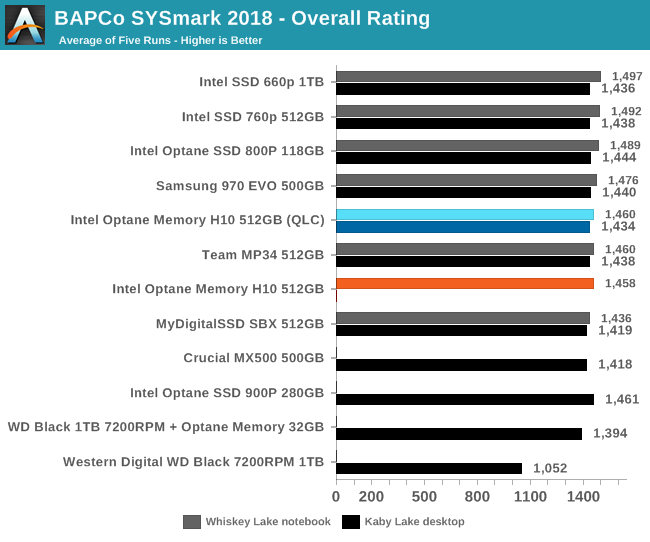
The Kaby Lake desktop and Whiskey Lake laptop change places depending on the subtest; sometimes a laptop in front thanks to its additional RAM, and sometimes a desktop computer in front thanks to a higher TDP. These differences usually have a greater impact than the choice of storage, although the responsiveness test shows that the parameters of the hard drive alone are not enough. Evaluating Optane Memory H10 with caching enabled is not much better than using only part of the QLC, and with the Optane cache it works at about the level of other, simpler SSD configurations.
SYSmark energy ratings show the total system consumption, excluding the display. Our Kaby Lake test system draws about 26 watts at idle and reaches peak power values of over 60 watts, according to our results. SATA SSDs rarely consume more than 5 watts and are idle with a fraction of a watt; moreover, SSDs conduct most of the test in idle mode. This means that energy use will be very similar. The laptop consumes significantly less power, despite the fact that the consumption of the display is also taken into account. None of the energy-intensive storage options (hard drives, Optane 900P) can fit into this system, so the energy consumption figures are also pretty close to each other.

The Optane Memory H10 was the most gluttonous version of M.2. Disabling the Optane cache saves a bit of power, but not enough to catch up with good TLC-based drives. The Optane SSD 800P has higher energy efficiency than most flash drives, but its low capacity is a hindrance to real use.
Optane Cache provides a sufficient performance boost in the PCMark 10 Extended test to bring the H10 to the lead among M.2 SSDs tested on a Whiskey Lake laptop. Essentials subtests show the most impact from the Optane repository, while tasks that require more computing resources are of little use. H10 looks similar with or without caching enabled.
This test starts with a recently erased disk, and fills it with sequential recording of 128 KB at a depth of queue 32, fixing the write speed of each segment 1 GB. This test is not representative of any normal consumer use, but it allows us to observe changes in disk behavior as it fills. This can allow us to estimate the size of the SLC write cache and get an idea of how much performance remains in those rare cases when the system continues to write data after the cache is full.
During continuous recording, the Optane cache on the Intel Optane Memory H10 does not really change the situation with the behavior of only the QLC part (Intel 660p) - the Optane cache itself is capable of only 350 MB / s. The NAND side SLC write cache is a more important factor that helps maintain a high write speed after an Optane cache overflow of 32 GB. But in the end, all the caches fill up, and the very slow write speed of pure QLC appears in all its glory.


The overall average write speed during full recording of the Optane Memory H10 is obviously lower than that of any other drive in this set. Intel 660p at 1 TB is already a bit slower than a 7200 rpm hard drive, and our sample H10 has half the QLC to work.
Optane's cache size on the H10 is 32 GB, but when testing random read operations, it is only suitable for workspaces of 6–8 GB, after which the cache starts to clear, and performance drops to about the level of a regular QLC disk. It looks like Intel could have reserved most of the Optane cache for use as a write buffer, and this could damage read-intensive loads.
Thank you for staying with us. Do you like our articles? Want to see more interesting materials? Support us by placing an order or recommending it to your friends, a 30% discount for Habr users on a unique analogue of entry-level servers that we invented for you: The whole truth about VPS (KVM) E5-2650 v4 (6 Cores) 10GB DDR4 240GB SSD 1Gbps from $ 20 or how to divide the server?(options are available with RAID1 and RAID10, up to 24 cores and up to 40GB DDR4).
VPS (KVM) E5-2650 v4 (6 Cores) 10GB DDR4 240GB SSD 1Gbps until the summer for free when paying for a period of six months, you can order here .
Dell R730xd 2 times cheaper? Only we have 2 x Intel TetraDeca-Core Xeon 2x E5-2697v3 2.6GHz 14C 64GB DDR4 4x960GB SSD 1Gbps 100 TV from $ 199 in the Netherlands! Dell R420 - 2x E5-2430 2.2Ghz 6C 128GB DDR3 2x960GB SSD 1Gbps 100TB - from $ 99! Read about How to Build Infrastructure Bldg. class using Dell R730xd E5-2650 v4 servers costing 9,000 euros for a penny?
SSD caching has been around for a long time, and allows you to squeeze maximum performance out of fast storage devices. In recent years, Intel Optane products using non-volatile 3D XPoint memory have ruled in the realm of small, expensive, and very fast drives. With Intel's third-generation Optane Memory caching memory, Optane's performance will qualify for a new product segment.

The first Optane Memory drives were tiny NVMe SSDs designed to speed up access to slower SATA drives, especially mechanical hard drives. Intel is currently continuing to use Optane memory SSDs to cache other NVMe SSMs, focusing on a combination of Optane flash memory and QLC NAND. Now they have put both types of SSDs on the same M.2 module to create the new Optane Memory H10.
For the first time, Intel Optane Memory H10 allows Intel to implement its Optane Memory caching technology in ultrabooks, where there is room for only one SSD, there is nothing to talk about SATA. The squeezing of two disks into a single-sided 80 mm M.2 module was made possible, in particular, due to the high density of Intel's four-bit flash memory QLC NAND. The Intel 660p QLC SSD has a lot of free space on the board in versions 1 TB and 512 GB, the Optane cache can potentially compensate for the shortcomings of the QLC NAND in performance and durability. Even with the placement of two types of memory on one module, the design of the H10 is very simple.

The Optane Memory H10 does not use any new ASIC or other hardware to make the Optane and QLC drive modules look like a single device. Caching is fully software-controlled, and the host system independently accesses Optane and the QLC H10. Each half of the drive has two dedicated PCIe lanes. Previously, all Optane Memory SSDs were PCIe x2 devices, so they don’t lose anything in the new device. But Intel 660p uses a 4x controller Silicon Motion NVMe, which is now limited to two lines of PCIe. Although, frankly, the 660p almost never required more bandwidth than the x2 channel can provide, so this is not really a bottleneck.

With slow QLC SSDs and Optane fast SSDs on the same Intel device, it was difficult to make difficult decisions about drive performance. For two large H10 capacities (512 GB and 1 TB), sequential read speeds of more than 2 GB / s are declared. This reflects the ability of Intel Optane Memory software to extract data from both QLC and Optane H10 at the same time. Recording can also alternate between different types of memory, but the maximum rating does not exceed any obvious limit for the performance of any of the devices. The specifications for random I / O for the H10 are between the performance of Optane Memory and 660p SSD devices, but much closer to Optane's performance. Intel is not trying to advertise the ideal cache hit rate, but they expect
The Optane cache should reduce the load that the QLC H10 writes, but Intel still estimates the endurance of the entire device as the same 0.16 disk rewrites per day. This is the same endurance as 660p QLC SSDs.



Marketing photographs of the Intel Optane Memory H10 feature an SSD with a two-color PCB to emphasize the dual nature of the drive, but in fact the drive board is monochrome. The layout of the board is unique thanks to two controllers and three types of memory, but it also clearly shows the two discrete products on which it is based. Half of the drive with QLC NAND is closer to the M.2 connector and is equipped with an SM2263 controller, plus one DRAM and NAND package. The familiar Silicon Motion test / debug connections are located on the border between NAND and Optane. The Optane side contains a small Intel Optane controller, a single 3D XPoint memory package, and most power management components. Intel SSD 660p and earlier solid-state drives with Optane Memory had a lot of free space on printed circuit boards;

At first glance, the Optane Memory software has barely changed; unless there’s now more flexibility in choosing caching devices. (Intel announced enhanced Optane Memory support for Pentium and Celeron processors on platforms that were already supported by Core processors.) If the boot volume is cached, Intel software allows the user to cache the selected files and applications to prevent them from being removed from the cache. Other than this option, there are no cache behavior settings.
Some OEM selling systems equipped with Optane Memory reported memory sizes as the sum of DRAM and Optane. That would make sense when we talk about Optane DC read-only memory modules connected to the processor's memory controller; what is misleading is the fact that the Optane product in question is an SSD.
Initially, the Optane Memory H10 will be an OEM-only part. The new SSD will be available to consumers only as a component of new systems, primarily laptops. Intel is currently considering the possibility of releasing the H10 in retail - both as a standalone product and as part of the NUC kit, no timing has been announced. Their motherboard partners have been setting the stage for H10 support for almost a year, and many desktop 300 series motherboards already support H10 with the latest publicly available firmware.
Platform compatibility
Placing two PCIe devices on the same M.2 card is new, to say the least. Intel has already installed two SSD controllers on one circuit board - in corporate high-end SSDs, for example, P3608 and P4608, but these drives use PCIe switch chips to split the x8 host connection into two x4 hosts for each of the two NVMe controllers on the board . This approach inflates the TDP of the device to 40 watts, which is not at all useful under the limitations of M.2.
There are several PCIe expansion cards that allow you to connect four M.2 PCIe SSDs through one PCIe x16 slot. Some of these cards include PCIe switches, but most use a host system that supports dual PCIe ports to split one x16 port into four independent x4 ports. Conventional consumer CPUs usually do not support this, and are limited to splitting x8 + x4 + x4 or just x8 + x8, and only when the lines are redirected to different slots to support the use of multiple GPUs. The latest processors for servers and workstations are more likely to support port separation up to x4, but motherboard support to enable this feature is not everywhere.
Even on processors where the x16 slot can be divided into four x4 ports, further separation up to x2 ports is rare or not possible at all. Chips that support many PCIe lanes, such as narrow x2 or x1 ports, are southbridge / PCH chips on most motherboards. As a rule, they do not support ports wider than x4, because this is the normal width of the connection to the processor.
Based on the foregoing, we tried Optane Memory H10 with almost all of the available PCIe 3.0 ports, using all the necessary adapters. Our results are shown below:

The Whiskey Lake notebook provided by Intel for this review is, of course, fully compatible with the Optane Memory H10 and will soon be available for purchase with the new drive. Compatibility with older and non-Intel platforms is basically what was expected: only the NAND H10 side is available. On these motherboards it will not be possible to use two PCIe devices that have a common M.2 x4 slot - they are not able to detect and initialize both devices. There are a few exceptions to note:
Firstly, the H370 motherboard in our Coffee Lake system was supposed to fully support H10, but GIGABYTE released a spoiled firmware update that supposedly added support for H10: both parts of NAND and Optane H10 became available when using the M.2 slot that connects to PCH , but caching cannot be enabled. There are many 300 series motherboards that have successfully added support for H10, and I am sure that GIGABYTE will soon release a patched firmware update for this specific board. Connecting the H10 to the PCIe x16 slot, which is connected directly to the CPU, does not provide access to the Optane side, reflecting the CPU's lack of support for PCIe port separation up to x2 + x2.
The only modern AMD system we had on hand was the Threadripper / X399 motherboard. All the PCIe and M.2 slots that we tried made the Optane H10 side visible, but could not detect the NAND.
We connected the H10 through two different brands of PCIe 3.0 switch. Avago PLX PEX8747 provided access only to the NAND side, which is to be expected, since it only supports dual PCIe ports up to x4 ports. The Microsemi PFX PM8533 switch supports split up to x2, and we hoped it would give access to both sides of the H10, but instead only got access to half of the Optane. The Microsemi switch and Threadripper motherboard may only need a firmware update to work with both halves of the H10; earlier generations of Intel PCH may have this potential, but Intel will not provide such updates. Even if these platforms could access both halves of the H10, they would not be supported by Intel's Optane Memory caching drivers. True,
Test system
Our main system for testing consumer SSDs is the Skylake desktop computer. It features a Quarch XLC programmable power module for detailed power measurements, and is used for IO ATSB trace tests and synthetic tests using FIO. But our system is older than Optane Memory, and Intel and their motherboard partners did not want to release firmware updates to support Optane Memory caching in Skylake generation systems. As a result, with the help of our test bench we can access only half of the disk - QLC NAND.

As happens with the release of the new Optane Memory, Intel sent us an entire system with the new Optane Memory H10 already installed and configured. So now the system for testing is an HP Specter x360 13t laptop with an Intel Core i7-8565U Whiskey Lake processor and 16 GB of DDR4 memory. In previous years, Intel provided desktop systems for testing Optane Memory products, but the main advantage of the H10 is that it is one M.2 module that is suitable for small systems, and therefore a 13-inch laptop was chosen. Intel has confirmed that the Specter x360 will soon be available for sale with the Optane Memory H10 as one of its storage options.
The HP Specter x360 13t has only one M.2 type-M slot, therefore, to test the caching configurations on multiple disks or options using SATA, we used the Coffee Lake and Kaby Lake systems that Intel provided for previous releases of Optane Memory. Application test results, such as SYSmark and PCMark, are greatly affected by differences in processor power and RAM between these machines, so we must list three sets of ratings for each tested disk configuration. However, our AnandTech Storage Bench I / O tests and our synthetic tests using FIO give almost identical results for these three systems, so we can make direct comparisons, and for each such test we list one set of points for each storage configuration.

The Intel Optane Memory caching software is for Windows only, so our Linux-based synthetic FIO testing had to be adapted to run on Windows. The configuration and testing procedure is as close as possible to our usual methodology, but some important differences mean that the results of this review cannot be directly compared with the results of our usual SSD reviews and the results published in Bench. In particular, in some cases, it was not possible to safely erase or format NVMe from Windows. Our testing typically involves erasing the disk between the main phases to restore performance, without waiting for the background SSD garbage collection to complete the flushing and clearing of the SLC cache. In a review of synthetic tests based on Windows tests,
Optane memory caching requires the use of Intel drivers. Our usual procedure for Windows-based tests is to use Microsoft's own NVMe driver, but not to use vendor-specific drivers. The Optane caching configuration tests in this review were conducted with Intel drivers, but the Windows driver is used by default in all tests with one drive (including tests on only one side of the Optane Memory H10).
Our standard Skylake test bench is designed to test NVMe SSDs in the main PCIe x16 slot connected to the processor. Optane memory caching requires the drives to be connected via the chipset, so there is little chance that overload on the x4 DMI channel may affect the fastest drives, but the H10 is unlikely to saturate this connection.
We try to include detailed power measurements in almost all of our performance tests, but in this review we are forced to skip many of them. Our state-of-the-art power measuring equipment cannot supply power to the M.2 slot in a laptop; it requires a regular PCIe x4 slot.
Application tests
With a sophisticated tiered storage system like the Intel Optane Memory H10, the most accurate benchmarks will be tests that use real-world applications. BAPCo's SYSmark 2018 and UL's PCMark 10 are two competing sets of automated application tests. Both have a common goal - to provide an assessment of the overall performance of the system, as well as several additional assessments covering various common use cases. PCMark 10 is a shorter test, and it provides a more detailed breakdown of various parameters. It also loads the GPU much more heavily, since 3D rendering is included in the standard test suite, and some 3DMark tests are included in the advanced test. The advantage of SYSmark 2018 is the use of full commercial versions of popular applications, including Microsoft Office and Adobe Creative Suite, and it includes the ability to measure the overall power consumption of the system during the test. The disadvantage of these tests is that they cover only the most common cases of everyday use, and do not simulate a heavy multitask load. None of their subtests uses the storage intensively, so often scores vary slightly when comparing fast and slow SSDs.
BAPCo SYSmark 2018
BAPCo SYSmark 2018 is an application-based benchmark that uses real-world applications to simulate the behavior of business users, with additional indicators of productivity, creativity and responsiveness. The results reflect the overall system performance and are calibrated against a reference system whose performance is 1000 points in each scenario. An assessment of, say, 2000 will mean that the system under test is twice as fast as the reference system.




The Kaby Lake desktop and Whiskey Lake laptop change places depending on the subtest; sometimes a laptop in front thanks to its additional RAM, and sometimes a desktop computer in front thanks to a higher TDP. These differences usually have a greater impact than the choice of storage, although the responsiveness test shows that the parameters of the hard drive alone are not enough. Evaluating Optane Memory H10 with caching enabled is not much better than using only part of the QLC, and with the Optane cache it works at about the level of other, simpler SSD configurations.
Power consumption
SYSmark energy ratings show the total system consumption, excluding the display. Our Kaby Lake test system draws about 26 watts at idle and reaches peak power values of over 60 watts, according to our results. SATA SSDs rarely consume more than 5 watts and are idle with a fraction of a watt; moreover, SSDs conduct most of the test in idle mode. This means that energy use will be very similar. The laptop consumes significantly less power, despite the fact that the consumption of the display is also taken into account. None of the energy-intensive storage options (hard drives, Optane 900P) can fit into this system, so the energy consumption figures are also pretty close to each other.

The Optane Memory H10 was the most gluttonous version of M.2. Disabling the Optane cache saves a bit of power, but not enough to catch up with good TLC-based drives. The Optane SSD 800P has higher energy efficiency than most flash drives, but its low capacity is a hindrance to real use.
UL PCMark 10
Graphs
Extended
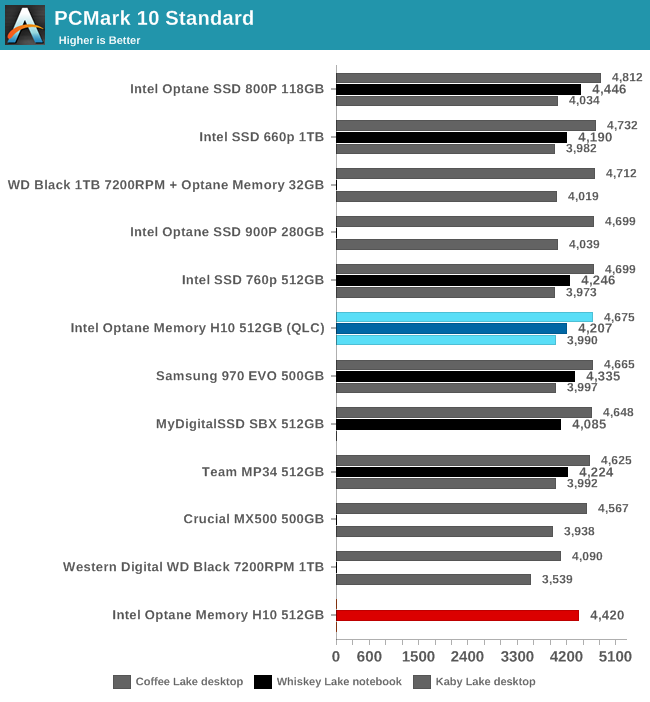
Standard
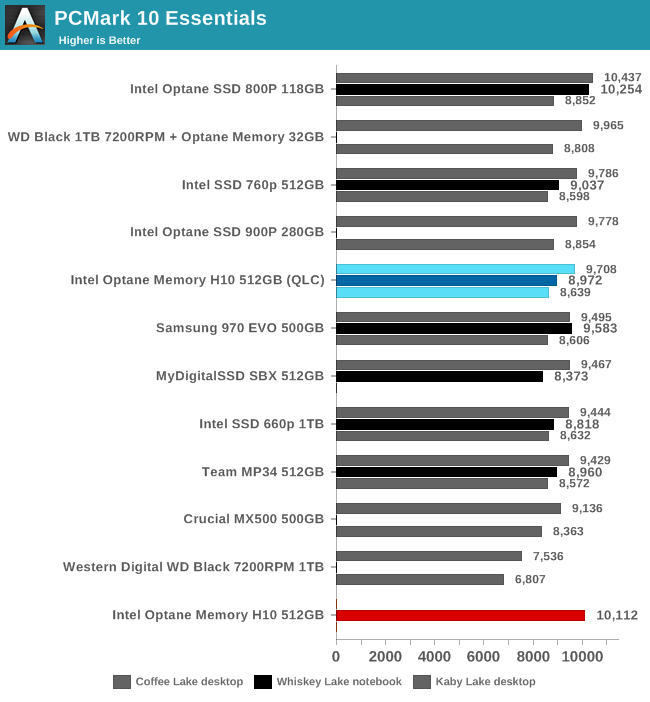
Essentials
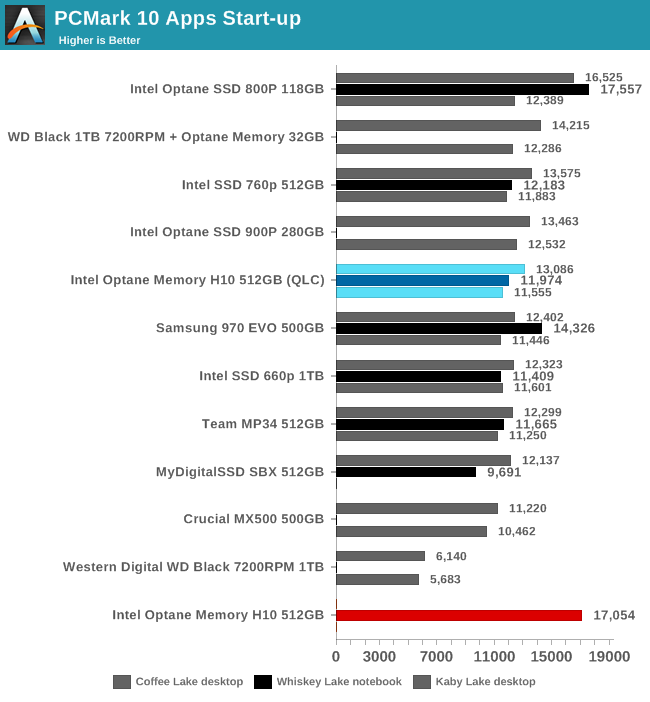
Apps Start-Up

Video Conferencing

Web Browsing
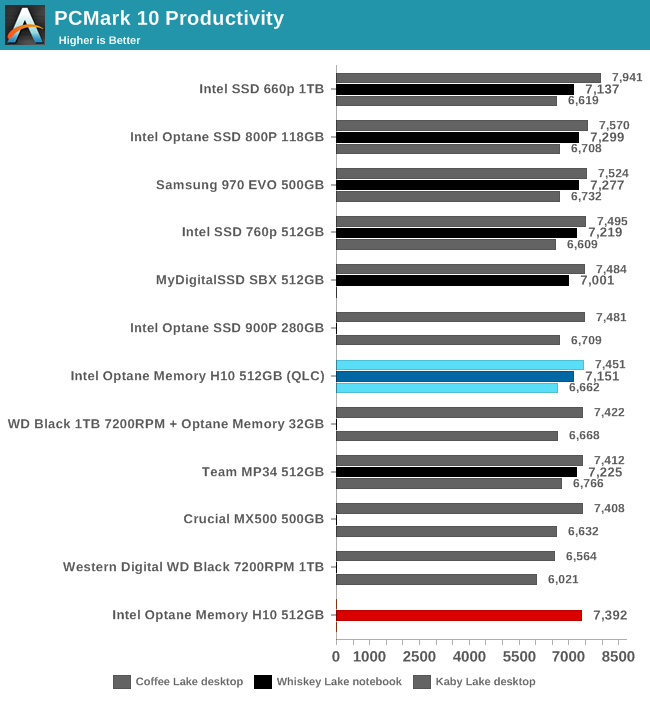
Productivity

Spreadsheets

Writing

Digital Content Creation

Photo Editing

Rendering Visualization

Video Editing

Gaming

Graphics
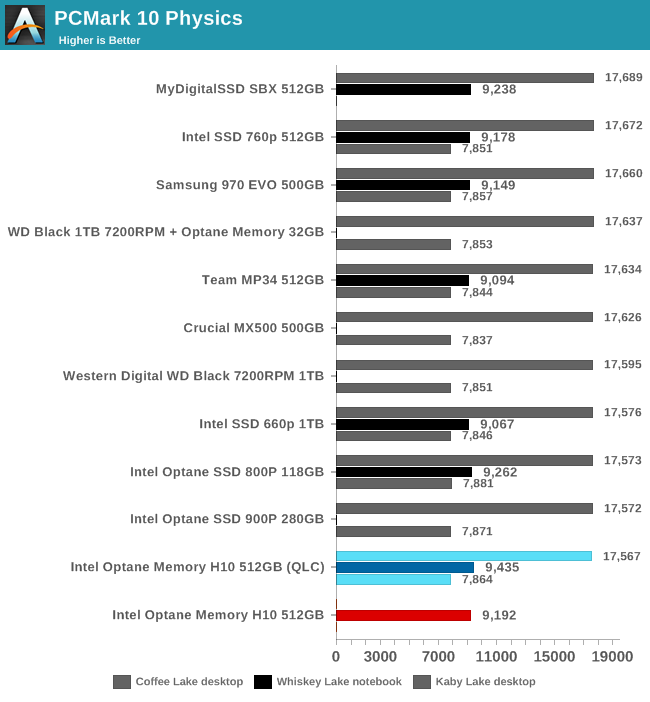
Physics

Combined

Extended

Standard

Essentials

Apps Start-Up

Video Conferencing

Web Browsing

Productivity

Spreadsheets

Writing

Digital Content Creation

Photo Editing

Rendering Visualization

Video Editing

Gaming

Graphics

Physics

Combined
Optane Cache provides a sufficient performance boost in the PCMark 10 Extended test to bring the H10 to the lead among M.2 SSDs tested on a Whiskey Lake laptop. Essentials subtests show the most impact from the Optane repository, while tasks that require more computing resources are of little use. H10 looks similar with or without caching enabled.
Vault filling
This test starts with a recently erased disk, and fills it with sequential recording of 128 KB at a depth of queue 32, fixing the write speed of each segment 1 GB. This test is not representative of any normal consumer use, but it allows us to observe changes in disk behavior as it fills. This can allow us to estimate the size of the SLC write cache and get an idea of how much performance remains in those rare cases when the system continues to write data after the cache is full.
Graphs
Intel Optane Memory H10 512GB
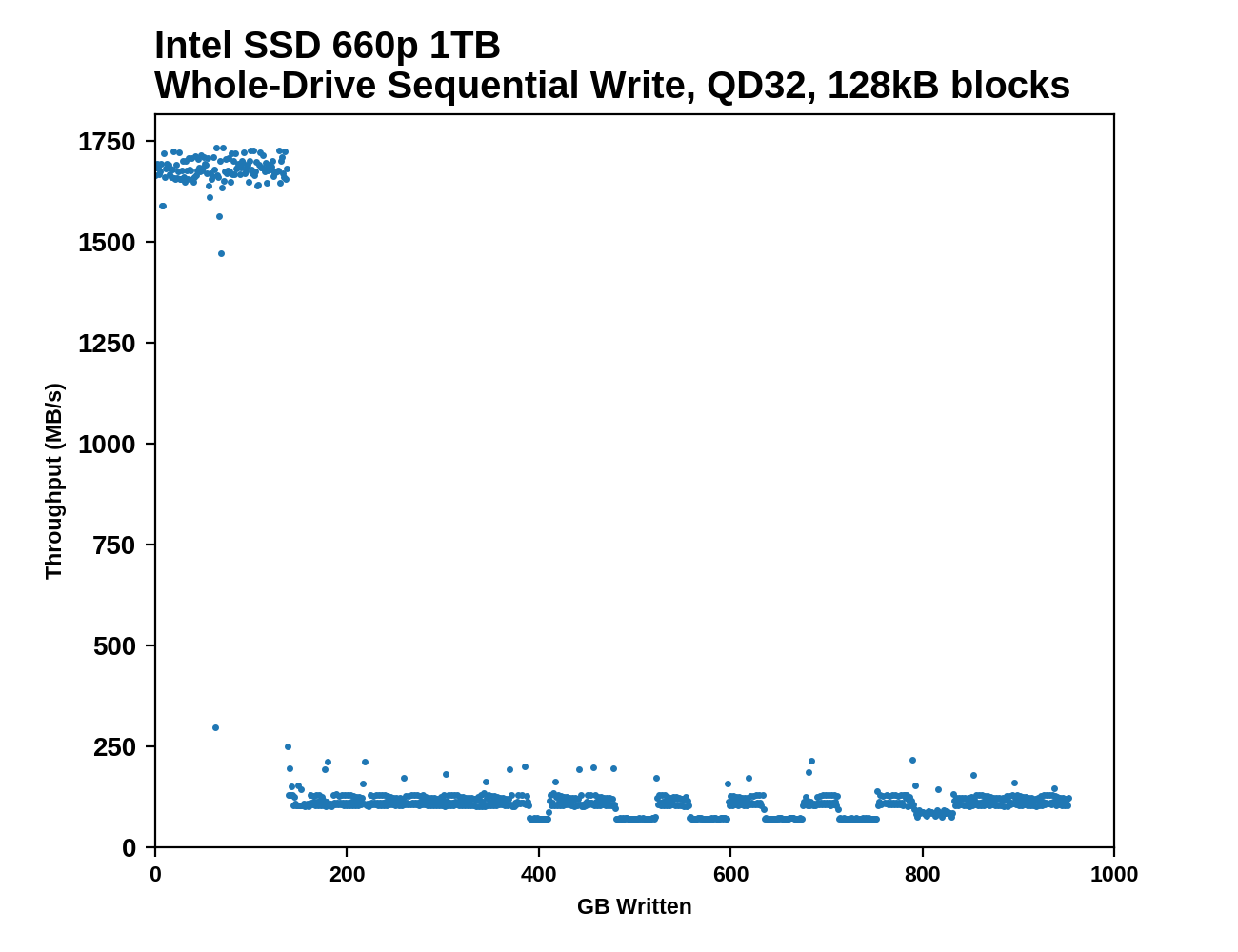
Intel SSD 660p 1TB

Intel Optane SSD 900P 280GB

Samsung 970 EVO 500GB

Intel Optane Memory H10 512GB (32GB Optane)

Intel Optane Memory M10 64GB
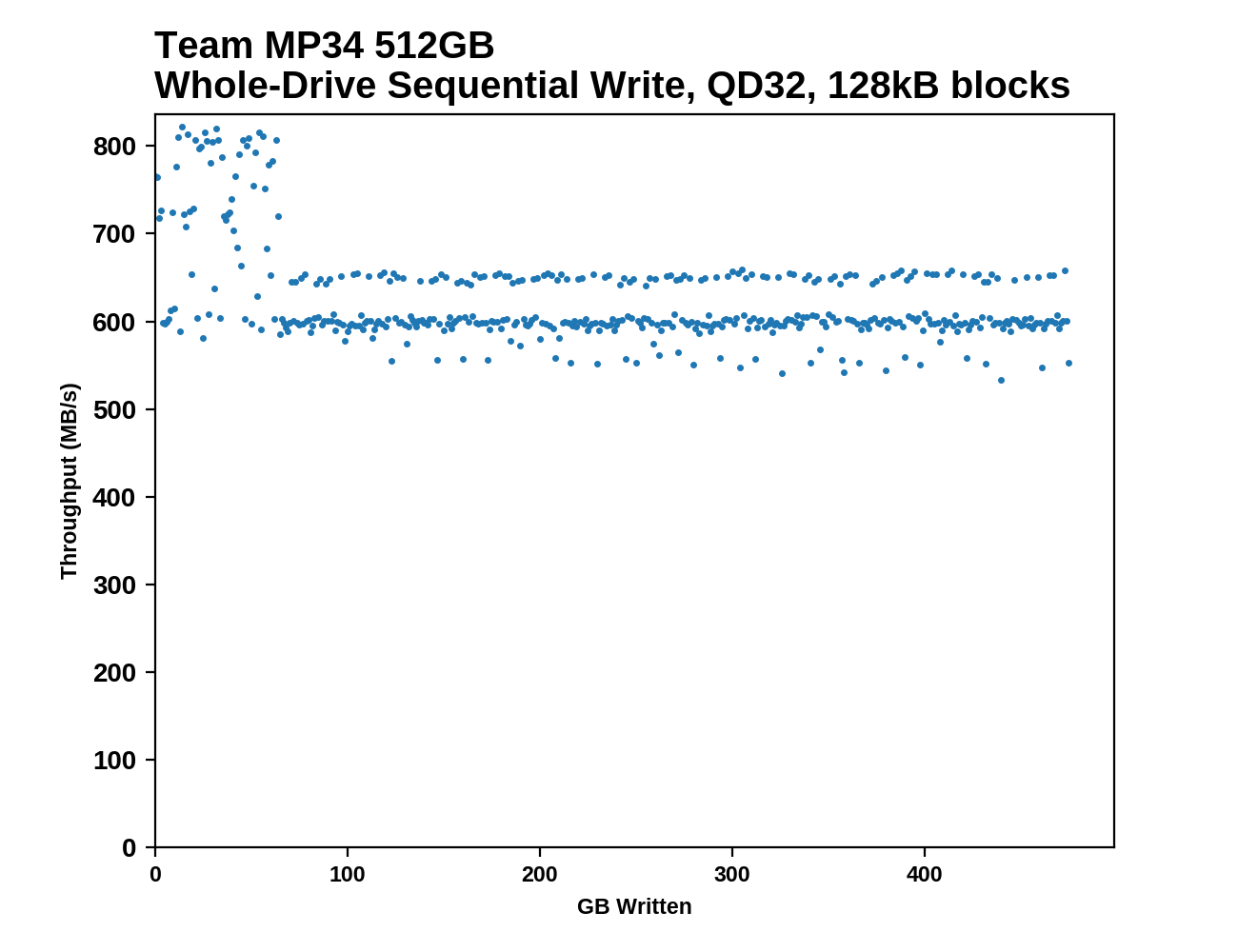
Team MP34 512GB
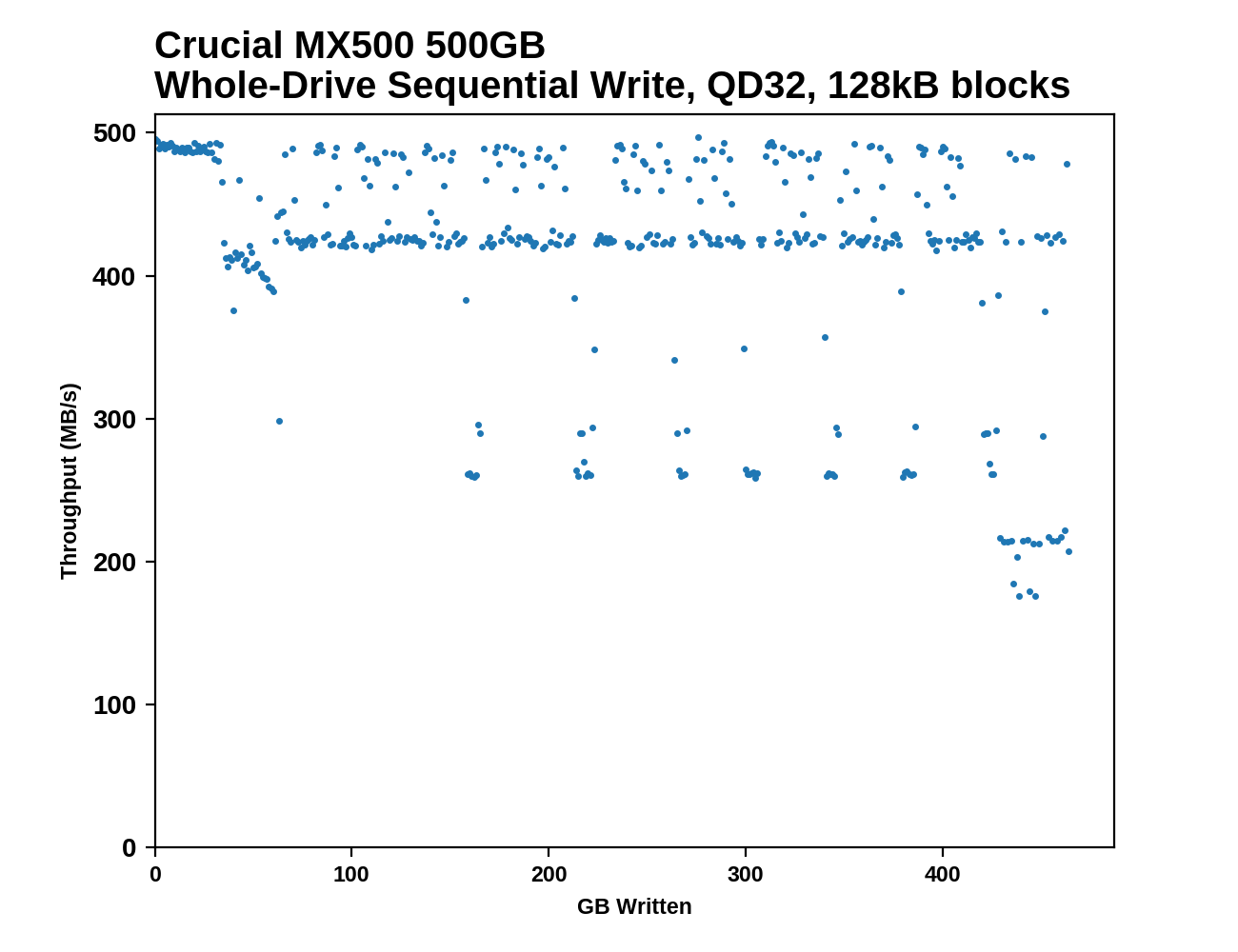
Crucial MX500 500GB

Intel Optane Memory 32GB

MyDigitalSSD SBX 512GB

Western Digital WD Black 7200RPM 1TB

Intel Optane SSD 800P 118GB

WD Black 1TB 7200RPM + Optane Memory 32GB

Intel Optane Memory H10 512GB

Intel SSD 660p 1TB

Intel Optane SSD 900P 280GB

Samsung 970 EVO 500GB

Intel Optane Memory H10 512GB (32GB Optane)

Intel Optane Memory M10 64GB

Team MP34 512GB

Crucial MX500 500GB

Intel Optane Memory 32GB

MyDigitalSSD SBX 512GB

Western Digital WD Black 7200RPM 1TB

Intel Optane SSD 800P 118GB

WD Black 1TB 7200RPM + Optane Memory 32GB
During continuous recording, the Optane cache on the Intel Optane Memory H10 does not really change the situation with the behavior of only the QLC part (Intel 660p) - the Optane cache itself is capable of only 350 MB / s. The NAND side SLC write cache is a more important factor that helps maintain a high write speed after an Optane cache overflow of 32 GB. But in the end, all the caches fill up, and the very slow write speed of pure QLC appears in all its glory.


The overall average write speed during full recording of the Optane Memory H10 is obviously lower than that of any other drive in this set. Intel 660p at 1 TB is already a bit slower than a 7200 rpm hard drive, and our sample H10 has half the QLC to work.
Graphs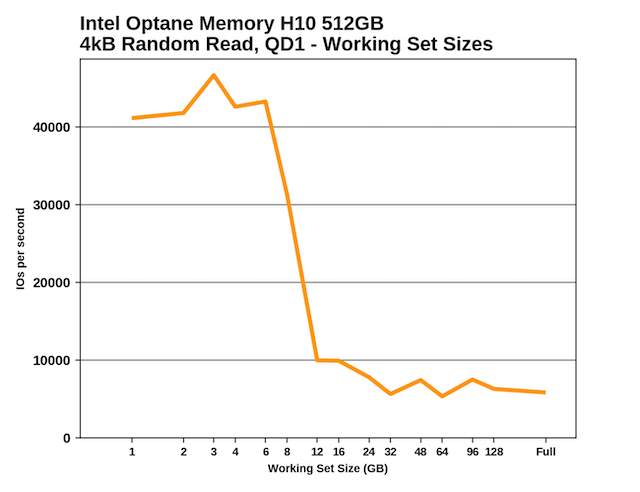
Intel Optane Memory H10 512GB

Intel SSD 660p 1TB

Intel Optane SSD 900P 280GB

Samsung 970 EVO 500GB

Intel Optane Memory H10 512GB (32GB Optane)

Intel Optane Memory M10 64GB

Team MP34 512GB

Crucial MX500 500GB

Intel Optane Memory 32GB

MyDigitalSSD SBX 512GB
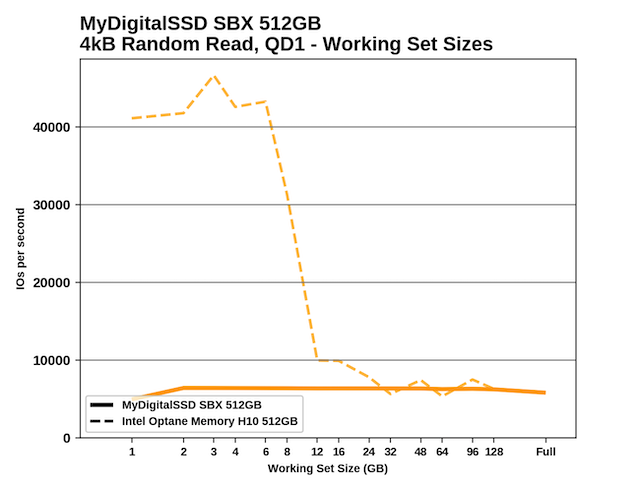
Western Digital WD Black 7200RPM 1TB

Intel Optane SSD 800P 118GB
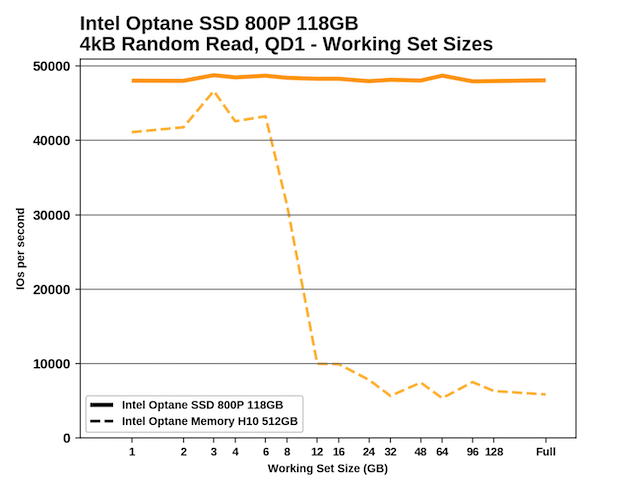
WD Black 1TB 7200RPM + Optane Memory 32GB

Intel Optane Memory H10 512GB

Intel SSD 660p 1TB

Intel Optane SSD 900P 280GB

Samsung 970 EVO 500GB

Intel Optane Memory H10 512GB (32GB Optane)

Intel Optane Memory M10 64GB

Team MP34 512GB

Crucial MX500 500GB

Intel Optane Memory 32GB

MyDigitalSSD SBX 512GB

Western Digital WD Black 7200RPM 1TB

Intel Optane SSD 800P 118GB

WD Black 1TB 7200RPM + Optane Memory 32GB
Optane's cache size on the H10 is 32 GB, but when testing random read operations, it is only suitable for workspaces of 6–8 GB, after which the cache starts to clear, and performance drops to about the level of a regular QLC disk. It looks like Intel could have reserved most of the Optane cache for use as a write buffer, and this could damage read-intensive loads.
Thank you for staying with us. Do you like our articles? Want to see more interesting materials? Support us by placing an order or recommending it to your friends, a 30% discount for Habr users on a unique analogue of entry-level servers that we invented for you: The whole truth about VPS (KVM) E5-2650 v4 (6 Cores) 10GB DDR4 240GB SSD 1Gbps from $ 20 or how to divide the server?(options are available with RAID1 and RAID10, up to 24 cores and up to 40GB DDR4).
VPS (KVM) E5-2650 v4 (6 Cores) 10GB DDR4 240GB SSD 1Gbps until the summer for free when paying for a period of six months, you can order here .
Dell R730xd 2 times cheaper? Only we have 2 x Intel TetraDeca-Core Xeon 2x E5-2697v3 2.6GHz 14C 64GB DDR4 4x960GB SSD 1Gbps 100 TV from $ 199 in the Netherlands! Dell R420 - 2x E5-2430 2.2Ghz 6C 128GB DDR3 2x960GB SSD 1Gbps 100TB - from $ 99! Read about How to Build Infrastructure Bldg. class using Dell R730xd E5-2650 v4 servers costing 9,000 euros for a penny?
